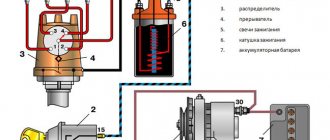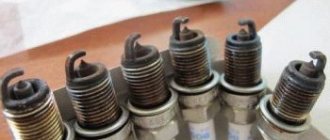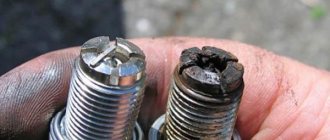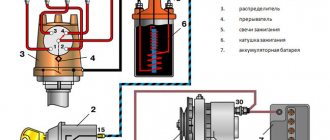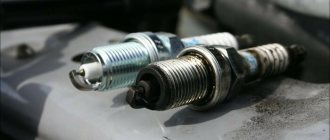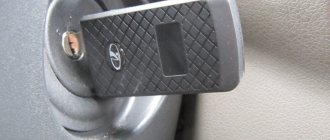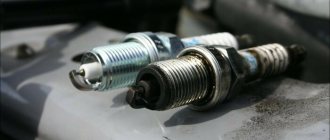Why does fuel flood the spark plugs in the injector?
If the spark plugs are flooded, then among the reasons, the condition of the piston system should be put in first place, because with ideal compression, the engine should start even with minimal spark values. However, only a new car can have such compression, while a used car already has some wear and tear. After only three years of operation, a VAZ car begins to suffer from this disease when fuel enters the injector.
It is typical that fuel can get onto the spark plugs in winter even in serviceable cars as a result of the system’s interaction with cold air. But in the summer, this problem in the vast majority of cases occurs if something is wrong with the car. The ignition control unit malfunctions - when a command is given to increase the fuel in the injectors, the fuel supplied in a large volume does not have time to ignite, hence wet spark plugs and other troubles. This applies to injection engines; for carburetor cars, in the absence of an ECU unit, this situation arises due to insufficient compression, and this directly depends on the condition of the piston group.
It is worth mentioning another problem when the spark plugs are stained with oil and the engine operation is inconsistent. There is an increased waste of expensive oil, problems with idling and “triple” of the engine. Among the reasons, we can name, first of all, the same wear of the piston group, increased oil pressure in the crankcase, failure of the valve stem seals and cuffs.
The engine does not start well: causes and solution to the problem
If the car does not start, you need to immediately determine the reasons that negatively affect the engine starting.
And for this it is necessary to systematize and reduce the number of options for engine operation problems. Does the engine have problems running “cold” or “hot”? Does the engine run on gasoline or diesel fuel? Answering these questions will help reduce the number of causes of poor engine performance. Why is the engine difficult to start? We need to understand the key reason!
With half a turn, it is possible to start only ideally tuned types of engines with a carburetor or mechanical injection of the first generations, which do not contain any electronics. In all other cases, the engine control unit must poll the sensors and, after analyzing their signals, give a command to fire a spark.
This takes several engine revolutions with the starter. In case of malfunctions, the process is delayed, which greatly irritates the owner of the car. In such cases, there is a problem with starting the vehicle. It is necessary to separate the factors that negatively affect the starting of a gasoline and diesel engine.
Why is good compression and rapid compression of the mixture important?
The process of combustion of the air-fuel mixture in cylinders
In order for a flash of the air-fuel mixture to occur, it must be compressed, and this must be done quickly enough - then the mixture will heat up and will be heated steam, only instead of water, it will contain gasoline as moisture. Such a mixture does not settle as a conductive film between the electrodes of the spark plug, and the spark discharge will not “go to ground”, but will ignite the mixture, which is also heated by compression.
In the case when the compression stroke occurs slowly, the pressure in the cylinder will not become sufficient - the compressed mixture of gases will be released through the gaps between the parts. In addition, the thermal energy acquired by the mixture will be completely inappropriately used to warm up the metal parts, and gasoline in liquid form will be “delivered” to the electrodes of the spark plug and will safely flood it. A person who has at least once inflated bicycle wheels with a pump without a plastic coating on the cylinder can imagine this very clearly. If you pump intensively, the pump body will become very hot, and the proportion of its heating due to piston friction will be only a small part. This is easy to verify if you run the pump “idle” - without screwing the hose to the spool - the pump body will hardly warm up even after fifty cycles. So, why dynamic compression of the mixture is needed, and how it, in combination with good compression, favors the flash of fuel, we found out. But do not forget that in cold weather:
- battery energy decreases;
- The engine oil thickens, making it difficult for the starter to crank the crankshaft. The starter begins to consume more energy, which is also needed for a powerful spark.
All this happens without proper dynamics. It turns out to be a “vicious circle” - and the candles are filled with gasoline. All of the above can give a clear answer to the question: “can the spark plugs on the injector be filled in in cold weather?” Of course it can.
Similar articles
How to check spark plugs
Checking compression in the cylinder with a compression gauge
But it happens that the candles are filled with oil. This is a separate case - engine repair is required. For initial diagnostics of the engine (not its control systems, namely the timing and timing gear mechanisms), you can use a compression meter. You measure the compression - the norm for a gasoline engine is 12 kg/cm2. If its value is significantly less than 10 kg/cm2, pour 30 - 50 grams of oil into the spark plug holes. If the compression has risen, repair the piston-cylinder pair, and this is already a “capital”. If the compression does not rise after filling the oil, there is a violation of the tightness of the combustion chambers - the valves do not fit tightly to the seats, they burn out, etc. If the values are the same, most likely the oil seals on the valve guides or the oil control piston rings are worn out. The rings, however, can “get stuck” in the piston grooves.
Seven reasons to fill candles when cold
If you decided to start the engine, but nothing happened, and instead you found spark plugs stained with gasoline, then this could happen for the following reasons:
- Insufficiently charged battery. Even if at positive temperatures the battery coped with its tasks without problems, the onset of frost could radically change the situation. It is enough for the battery to be discharged by 50%. Even with this indicator, there may not be enough power to start the engine.
- Cylinder wear. A worn-out engine cannot run perfectly, so it is not surprising that new engines have insufficient cylinder compression. In combination with other factors, this can lead to flooded candles.
Compression test
Old spark plugs. It is not for nothing that this part is consumable and requires regular monitoring and, if necessary, replacement. If you do not change the spark plugs for a long time, then defects appear on them, which can prevent spark formation, which is so necessary to start the engine.
Malfunction of structural elements of the ignition system. Faulty wires and soured contacts can be one of the reasons that causes spark plugs to flood.
Wear of armored wires
Poor quality fuel. This does not mean that you were deceived and sold bad gasoline. The point is that in winter there are a number of factors that can negatively affect the quality of fuel.
Similar articles
We select spark plugs denso, ngk, bosh, beru, champion by car make
For example, the formation of condensation in the fuel tank and its entry into gasoline. As a result, the fuel does not ignite at the right time, which becomes one of the reasons for “wet” spark plugs.
- Unsuitable oil in the engine. If we are talking about winter, then you need to use oil with a viscosity that will not load the engine, otherwise this will become another factor creating conditions for flooding.
- Accumulation of carbon deposits in the combustion chamber. Short trips in the city do not allow the engine to “breathe”. As a result, carbon deposits form, which settles in a thick layer on the walls of the combustion chamber. The mobility of the piston rings decreases, and with it the compression in the cylinders. As a preventative measure, it is necessary to run the engine at high speeds. Sometimes, to return the piston rings to mobility, special flushing of the system is required.
Carbon deposits in the combustion chamber
Sometimes it happens that there is a spark and the starter rotates normally, but gasoline still pours out. In this case, it is necessary to carry out diagnostics to determine the serviceability of the spark plugs. In rare cases, the problem may be in the ECU itself.
Studying plaque on candles
They say that when candles are “flooded,” black soot forms. Let us clarify: it should not consist of inclusions. All metal, in turn, will be covered with an oily coating. Dry carbon looks different...
Oily layer and dry soot
The photo shows two cases. “Our version” is on the right.
We recommend: Which is better, electric corrector or hydrocorrector for headlights on a VAZ 2110: pros and cons
And soot can also be brown. And it always, in 100% of cases, is formed due to flooding with gasoline.
Dark brown soot
An oily coating, as in photo 1, is, nevertheless, the result of oil ingress. But an oiled candle does not work correctly - it will also be “flooded”.
With regular “flooding,” carbon deposits form, which we see in photo 1 on the right and in photo 2. The rest does not apply to our case.
Why is this happening
The operation of injection engines, where the mixture is formed in the volume of the fuel rail, is always controlled by a special controller. The control unit in question is also called “ECU”:
The injection engine will not start without an ECU
The program installed in the unit’s memory constantly determines how many milliseconds each of the injectors should open. The longer the nozzle is open, the richer the mixture is formed. And in winter, at low temperatures, the controller strives to enrich the mixture to the maximum. And then the following happens:
- The concentration of gasoline in the mixture turns out to be maximum, but the temperature of the fuel and air remains lower than typical for the summer period;
- Compression in the cylinder, due to worn parts, may be insufficient;
- If there is carbon deposits on the spark plug contacts, sparking does not occur as the developers expected.
In total, these three factors lead to the following result: the fuel does not burn, but gets onto the spark plug contacts. As a result, sparking stops, and then, when you try to start the engine, gasoline is pumped into the cylinder. Then at a certain moment the fuel detonates.
Let's decide what this means and why it happens?
It's no secret that an internal combustion engine is a rather complex device in which several sequential processes take place. The first process is the supply of a fuel-air mixture, during which fuel is mixed with air and enters the engine cylinders. The second is the compression of the said mixture by the cylinders, by raising the piston as high as possible with the valves closed. The third is ignition: a spark is supplied to the cylinders, where the fuel-air mixture is under pressure, provoking a mini-explosion, ignition of the said mixture and the downward movement of the piston. The fourth process is the release of exhaust gases through a piston and valves into the gas exhaust system.
Similar articles
Cylinder misfire
This is how the internal combustion engine operates under normal conditions, but in winter (in the cold) failures may occur in this sequential cycle.
Due to the fact that cold air is much more enriched in oxygen than warm air, a larger volume of fuel is required to ignite it. The ECU knows about this and sends the appropriate command to the injectors. They, in turn, send an upwardly adjusted amount of fuel into the combustion chamber, where at this time the starter tries to simultaneously create good compression and give a spark to generate a flash. Taking into account the poor quality of gasoline at our gas stations and the presence of some wear and tear on parts (we are not talking about new cars here, since the compression in them is ideal, so the question: the spark plugs are flooded, what to do? - it’s simply not worth it), it’s good to do it He doesn't always succeed. As a result, the mixture does not ignite, and the fuel supplied to create a chemical reaction floods the candles, completely paralyzing their work. This can happen for only 2 reasons:
- due to an overly simple and already outdated injection system in carburetor engines, in which there is no measure of fuel supply (even if the car does not start, the system will continue to “pour” gasoline in the amount “prescribed” in the settings), as well as its incorrect settings;
- (found on both a carburetor car and an injector) due to a weak battery, which at low temperatures is simply not able to create the necessary voltage to ignite a spark.
It is therefore obvious that in order not to be left without a means of transportation in winter, when preparing your car for the winter season, be sure to check its battery and carburetor settings (if your car is equipped with one).
There is always a way out
But even inexperienced drivers will find a way out of any situation: the battery can be recharged, the spark plugs can be “blowed out”, cleaned and dried, or bought new ones. Moreover, the cost of candles is low.
How to start a car if the spark plugs are flooded,
we will tell you and also try to raise the question of why this is possible and how to eliminate such a problem. It may seem strange to some that the performance of candles largely depends on weather conditions, but this is true. Most often, such problems arise in the cold season. And since most cars are stored outside garages, such starting problems are a very common occurrence.
Why is this happening?
crankshaft
How to determine what exactly happened on the engine of your car? To do this, just unscrew the ignition devices and inspect them. You will see a wet and dirty product with a strong smell of gasoline. This can also happen when the service life of the ignition devices is approaching or has already reached the end. The spark gap has spontaneously increased, which makes sparking much more difficult.
How are deposits removed?
Experts recommend cleaning not the electrodes of the devices, but the skirt of the central insulator. After all, it is the coating on this part that contributes to the removal of the spark in an unknown direction. And this does not lead to ignition of the combustible mixture in the engine cylinders. In various sources you can see recommendations on the use of a metal brush for such purposes, but today this is not always acceptable. It is strictly prohibited to use it for iridium spark plugs.
We can recommend this method of removing carbon deposits. You need to find an old toothbrush, some washing powder, which should be diluted in a small amount of water. This mixture thoroughly cleans the working part of the candles. After such a bath, they should be dried, for example, using a hairdryer or electric stove. When they heat up to such a state that it is impossible to pick them up, you need to screw them into place as quickly as possible.
The winter season is traditionally considered the most difficult for motorists. In wet and cold weather, starting the engine can often be a very difficult task with many unknowns. One of the very common problems that drivers face is spark plugs that are flooded with gasoline.
Why does the candles flood in winter?
The main reason why spark plugs cannot ignite the air-fuel mixture in cold weather is a weak battery. In a battery discharged by more than 40-60%, there will not be enough current to start the starter and to supply enough voltage to the spark plugs until a spark is formed. As a result, fuel is properly supplied to the cylinders, but does not ignite due to a too weak spark - and the spark plugs are flooded.
Another reason why spark plugs flood in winter is a malfunction of the ignition system itself. Either the spark plugs have exhausted their service life - and then, due to incorrect gaps, defects in the housing and electrodes, they are not able to produce a normal spark, or the high-voltage wires and their contacts are damaged
It is also worth paying attention to other elements of the system, in particular, the condition of the ignition coils
Also, the cause of the failure may be in a complex of sensors and ECU: in cold weather, the electronic control unit receives information from sensors (mass air flow sensor, lambda probe, etc.) that the injectors should supply more gasoline to enrich the mixture. And if some sensor is lying, and the control unit enriches the mixture, the injectors overfill fuel - and the spark plugs drown in excess gasoline, unable to ignite it.
Fuel of low quality or with an admixture of water due to condensation on the walls of an empty tank also prevents the mixture from igniting, while the spark on the spark plugs may be normal. Therefore, in winter it is recommended to keep the fuel tank full and switch to gasoline with a higher octane number: AI-95 instead of AI-92, for example.
In real life, it is typical when the candles flood due to a combination of all factors.
Let’s imagine a not-new engine with some wear on the CPG (compression is still normal, but no longer ideal), a battery that has become weak in the cold, thickened oil in the crankcase, tired spark plugs, a half-empty tank of gasoline. And frost in the morning.
When the owner tries to start the engine, the ECU monitors the temperature outside and the temperature of the engine, the amount of oxygen in the air that enters the intake, etc. and “understands” that it is frosty outside, and the engine needs to be started so that it does not stall - and gives the injectors a command to increase the amount of gasoline supplied - so that the enriched mixture is enough for “warm-up idle speed”.
As a result, the injectors supply fuel mixed with water into the cylinders, the starter slowly cranks the crankshaft in thickened oil from a half-dead battery, and in a cold engine with increased clearances and less-than-ideal compression, the spark plugs try to ignite the fuel due to a weak spark. The result of this scenario will be flooded candles.
What to do to prevent candles from flooding
We have looked at the reasons why the spark plugs on the injector are flooded. Now we need to figure out what to do in order to forget about the fact that gasoline floods the candles in cold weather. To do this, a number of preventative measures should be taken before frosts begin.
First of all, you need to monitor the battery charge level. In winter, it is better to equip your car with more powerful batteries. To prevent fuel from flooding the injector, the battery must be maximally charged. Therefore, if necessary, it must be recharged at night.
With the onset of cold weather, special attention should be paid to the quality of gasoline and oil. You shouldn’t skimp on this and it’s better to purchase only a high-quality product that suits the season.
Naturally, you need to monitor the serviceability of the spark plugs.
Clean them regularly and change them on time if they are faulty. The piston group also requires attention. It is responsible for creating compression, so when it wears out, the necessary pressure to ignite the air-gasoline mixture will not be achieved and fuel floods the spark plugs on the injector.
If it is frosty outside, then when starting the engine it is recommended to first load the battery. Then turn it off for a few minutes. Crank the starter and start the engine. If the launch is unsuccessful, then you need to wait about 10-15 minutes so as not to flood the injector, and repeat the launch. It is necessary to check the serviceability of the car before the onset of cold weather. If all components work properly, then there will be no problems starting the engine.
To summarize, the following conditions can be identified for optimal injector operation:
- the starter must be in working condition;
- the battery is fully charged;
- the lubricating fluid must correspond to the season;
- all high voltage wires and spark plugs must be in good condition;
- nozzles must be adjusted and kept clean;
- use only high-quality fuel.
To self-clean the engine, experienced car enthusiasts recommend going out on the highway every month and driving the car at a speed of 120 km/h.
Self-cleaning of the engine occurs due to strong pressure. You can clean the engine by running it in the morning at five thousand rpm for 10 minutes. The effect is similar to driving along a highway.
Monitor the condition of your car, then you will avoid unpleasant situations and save your nerves.
What to do if the spark plugs on the VAZ-2114 injector are flooded
Experts advise that if such a problem is detected, initially check the correct spark formation on all spark plugs. To do this, you will have to examine each of them:
- turn off the ignition;
- remove the plastic engine cover;
- disconnect one of the battery terminals;
- remove the high-voltage connectors (to do this you just need to pull them out by the rubber caps);
- dismantle each spark plug using a special spanner (also called a “spark” wrench);
- close the spark plug well (this should prevent dust from getting into it).
As soon as the candle is in your hands, we immediately inspect it for the presence of soot. After this, the distances between the spark plug contacts are checked - the digital values must correspond to the part passport.
If carbon deposits are noticed on the spark plug element, it must be removed. This can be done with a brush - either a toothbrush or a metal brush. After cleaning, put it back in place, after drying it. To do this, just use a regular hairdryer.
Another way to dry spark plug elements directly in the engine, without unscrewing them, is to purge the cylinders of unburnt fuel mixture:
- remove the wiring block from the ignition module (necessary for reinsurance so that the module does not burn out when cranking the engine);
- turn on the starter;
- press down the gas pedal;
- Turn the starter for 7 minutes.
As a result of such actions, air is sucked through the ramp. If it is noticed that the spark plug is in a faulty condition, then it is simply replaced with a new one. Of course, checking, cleaning and drying old spark plugs each time takes a lot of time. Therefore, experts advise buying a set of new spark plugs and simply replacing the filled ones.
When the problem turns out to be not in the spark plugs, but in the carburetor or engine, a completely different repair will be required.
The spark plugs are filled with gasoline, what should I do?
There are several options to correct the situation: the simplest is to unscrew the spark plugs from the engine and dry them. After removing the spark plugs, you need to turn the key in the ignition switch so that the starter spins for about 15 seconds, after which you can put the dried spark plugs back in and turn on the engine. This is what the car manufacturer recommends and writes in the operating instructions.
You may also be interested in: Do-it-yourself car body repair before painting
But there is another proven method - if the spark plugs are filled with gasoline, then before unscrewing the spark plugs and starting to dry them, you should try to start the engine using the purge mode.
To turn on this mode, in a fuel-injected car you need to press the gas pedal to the floor and turn the key in the same way so that the starter spins for about 12 seconds, after which you need to take your foot off the gas pedal, and the starter should continue to spin. The engine should start at this moment, after releasing the gas pedal.
It turns out that when you turn off the fuel supply, the spark plugs are blown out with air. If after such manipulation the engine still does not start, then you need to dry the spark plugs. Injection spark plugs are no different from carburetor spark plugs, so you can safely do the same as they have been doing for centuries - they unscrewed the spark plugs, cleaned them of carbon deposits with a metal brush, and therefore dried them with a hairdryer or gas stove. After drying, you can check the gaps and screw the spark plugs back in. After this, the engine should definitely start.
To prevent this situation from occurring frequently, you need to periodically clean the spark plugs or change them on time. If you fill the spark plugs on an injection engine with gasoline every time when they are cold, this means that you need to do diagnostics - check whether the spark plugs, ignition coils, high-voltage wires, injectors and Hall sensor are normal. If all these components are normal, then the question of whether the injector can fill the spark plugs will disappear by itself.
Signs of flooded candles
Signs of faulty spark plugs. List
- 1. The starter turns for a very long time, but the engine does not start or starts, but after a long time;
- 2. Unpleasant noise made by the engine when the car warms up or during idling;
- 3. Increased gasoline consumption during vehicle operation;
- 4. The number of harmful substances from the exhaust pipe has increased;
- 5. Spark plugs are wet or filled with fuel;
- 6. Weakening of the car’s traction, lack of power and failure to gain the required speed.
- 1. Open the hood and secure it with a stand;
- 2. Blow compressed air through the engine to clear it of road dust. To do this, you can use a regular home vacuum cleaner, only by turning it on to “exhale” air, and not to suck it in;
- 3. Remove high-voltage wires or ignition coils, depending on the type of engine, to get to the spark plug wells;
- 4. Using a spark plug wrench, unscrew all the spark plugs and remove them using wires or a special head;
- 5. Check for the presence of oil and foreign objects in the wells using a flashlight, so as not to provoke rapid failure of new spark plugs;
- 6. Insert and tighten new spark plugs, connect the high-voltage wires and you can start the car engine;
- 7. After starting the engine, check for detonation, which may occur due to the installation of low-quality spark plugs.
AutoFlit.ru
AutoFlit.ru
- “Why do the spark plugs on the injector flood”;
- “What should be the gap on the spark plugs.”
AutoFlit.ru
Why is the Renault Duster 2 liter engine difficult to start? Frenchman's problems
- Fuel problem;
- Faulty spark plugs;
- Problem with the injection control unit;
- Throttle valve clogged;
- Immobilizer lock.
“Why are the spark plugs on the injector flooding”; “Which spark plugs are better, platinum or iridium.”
AutoFlit.ru
What does the color of spark plugs mean, and what color should they be?
- Checking on a cold engine. Having unscrewed a spark plug on an engine that has been turned off for a long time, it is not always possible to determine the color correctly, for example, during this time the gasoline dries completely;
- Check after warming up the car at idle speed. In this case, carbon deposits accumulate on the candles due to the over-enriched mixture. But in this case it does not indicate problems with the engine.
- “After how long and how often do you need to change spark plugs”;
- “Which spark plugs are better than NGK or Denso and how to distinguish a fake;
- “Which spark plugs are better, platinum or iridium?”
AutoFlit.ru
List of reasons for a lean mixture on the injector. What needs to be checked and how to do it?
- The most common is dirt. It clogs the injectors and filters, resulting in insufficient fuel supply to the engine;
- Extraneous air leak. Either a crack has appeared in one of the hoses and pipes connected to the manifold, or it itself has become depressurized, or some connections are poorly tightened;
- The fuel pump died quietly. Or it’s still alive, but works at a quarter of its strength, which means it will have to be changed anyway.
AutoFlit.ru
Start the engine
Just yesterday, the scooter or moped was working normally, but in the morning its engine simply does not start. Probably the reason is a flooded candle. You can, following the instructions, take out and dry the candles, but if you are short on time, you should try the traditional method.
To use it, you first need to let the scooter stand for a little time - about 5 minutes. Then you should completely unscrew the gas handle and turn the starter. Continue for about fifteen seconds. At this time, there will be no fuel supply to the chamber, so it will be purged with air. Most likely, such a simple operation will be enough and the engine will start. This should work on both 2t and 4t scooters.
If the iron horse does not start, you will have to use another method. To implement it, you will need a little time, patience and a spark plug. First, you should unscrew the spark plug and make sure that it is the problem. It can be cleaned with a brush and then dried with a hairdryer. However, any heat source will do: hotplate, oven or gas burner. Next, it is recommended to blow out the cylinder in the same way as with the traditional method. Then insert the candle back. Now the engine just has to start. If this does not happen now, you will have to replace the spark plugs and carry out diagnostics.
After the engine has successfully started, there is a temptation to leave everything as is. However, it is recommended to determine what the problem was. Regardless of whether the spark plug on a moped or scooter is flooded, most likely some parts require cleaning or replacement. But even if the reason is only that the vehicle is not new, there are ways to avoid a flooded spark plug in the future.
Pro Tips
EVAKUATORNN Blog Why the engine does not pick up, or picks up speed poorly, does not pull
The following tips from professionals will help, if not completely, then at least in most cases, to prevent difficulties with starting the engine due to spark plugs filled with gasoline.
how to keep a car in good technical condition
Keeping all car components in perfect condition will help reduce the risk of unpleasant situations.
Among the main requirements, the most important ones should be highlighted:
- high-quality battery charging
- starter serviceability
- high quality oil and compliance with its parameters
- temperature outside, outside the car
- use quality spark plugs
- Maintaining high voltage wiring in perfect condition
- carry out timely cleaning and adjustment of the nozzle, and the best option should be considered
- cleaning using special equipment; It is recommended to resort to cleaning by adding special impurities to the tank only in exceptional cases, pouring only high-quality gasoline into the tank
Among the “folk” recipes we can recommend:
- After a day or two, while driving, for 10 seconds, increase the engine load to 4.5 - 5 thousand revolutions, this guarantees self-cleaning of the spark plugs from soot and cleans the chamber of existing deposits.
- In order for the engine to start reliably in cold weather and the spark plugs not to be flooded with gasoline, once a month you will need to “crank the engine”, the distance is from 50 to 100 km, at a speed of at least 100 km per hour. Use only high quality fuel.
These simple steps will help you independently monitor the condition of the car, and you will be able to save on the services of car service specialists.
how to start the engine if the spark plugs are flooded
The issue of starting the engine can be solved in different ways.
The operating instructions recommend the following procedure:
- candles are unscrewed and dried
- While the spark plugs are removed, crank the starter for 15 seconds
- dried candles are inserted back
- start the engine
You can use the second, “folk” method, the effectiveness of which has been proven in practice. Before unscrewing and drying the spark plugs, you can use the purge mode.
Starting injection engines is carried out as follows:
- the gas pedal is pressed all the way to the floor
- Using the starter, the engine cranks for ten seconds, after which the gas pedal can be released
After such actions, starting the engine should proceed without problems; blowing air through the spark plugs with the fuel supply shut off usually gives a good result.
If the engine does not start after a couple of attempts, you should not drain the battery and turn the starter in vain. You will need to remove the spark plugs, clean them with a brush (you can take a regular toothbrush or a metal brush) from carbon deposits, dry them over a lit stove burner, in the oven, using a hairdryer.
While the dried spark plugs are not installed, crank the engine for 5 seconds and press the accelerator pedal all the way. This action will facilitate the complete removal of excess combustible mixture from the combustion chamber.
After checking the gap, the spark plugs will need to be screwed into place. The engine should start normally.
Experts recommend systematically cleaning spark plugs and periodically replacing them, especially when using used cars.
The systematic occurrence of a situation with spark plugs flooded with gasoline is a signal that diagnostics are required:
- injector cleanliness
- functioning of the Hall sensor
- process of spark release from the ignition coil
- the spark plugs themselves - on the quality of the supplied spark
Features of starting a car in cold periods
In cold weather, before starting, you must first load the battery, then disconnect it for a while. After waiting a few minutes, you can try turning the starter to start the engine. If you fail to start the car on the first try, then in order not to fill the injector, you must wait a few more minutes. If all preventive measures were carried out in full before the frost, then there should be no problems with filling fuel.
We can list several conditions that are considered optimal for normal operation of the injector:
- presence of a working starter;
- maximum battery charge. The battery is powerful and in good condition;
- seasonal lubricant is used;
- spark plugs and high voltage electrical circuits must be in perfect condition;
- clean, adjusted nozzles are installed;
- The gas tank is filled with high-quality fuel.
There is an opinion among experienced drivers that driving a car along the highway at a speed of 120 km/h helps to self-clean car systems, including the fuel system. You can also run the engine at 5000 rpm for about 10 minutes in the morning. The effect is similar to racing on a track.
It is believed that when high pressure is created in the systems, self-cleaning occurs. These measures can only be carried out if the car is in good condition and a significant increase in pressure in the systems will not harm it.
What steps do you need to take to get started?
The question arises, what to do if the car is not old, all systems are in order, but in the cold it refuses to start? When turning the spark plugs out, it turns out that they are wet. As already mentioned, in the cold season, the cause of this phenomenon may be weak compression, low-quality fuel or a weak battery.
Let's look again at the manufacturer's instructions. The book on car operation defines the following algorithm of actions:
- Turn out the spark plugs.
- Wipe them thoroughly and dry them.
- Run the starter for a few seconds.
- Put everything in place.
Often, car owners clean the injector using various fuel additives. This is not recommended at all, firstly, the quality of the fuel mixture is lost, which negatively affects the operation of the entire piston group, and secondly, the injector should be cleaned using special equipment.
Experienced drivers carry several sets of spare spark plugs with them . The quality of the spark produced depends on the technical characteristics of this ignition component. There is no point in saving on candles, their cost is not that high, and low-quality candles can cause a lot of problems.
Why are the candles wet?
Sometimes a removed spark plug may be wet. This may be caused by gasoline, oil or coolant (antifreeze). Each of these liquids has its own determination methods.
Gasoline can be easily identified by its high volatility. By unscrewing the spark plug, the gasoline quickly dries out. Most often, filling with gasoline occurs when starting a cold engine. This can also happen due to incorrect ignition adjustment.
Oil on the spark plug electrodes may appear due to significant wear of the oil seals in the valves. Less commonly, the cause may be wear of the engine cylinder-piston group or breakage of the oil rings on the piston. Any of these faults requires immediate repair.
The amount of oil on the spark plugs can indicate how serious the problem is. When diagnosing, it is best to use a set of new spark plugs recommended by the car manufacturer, since droplets of oil are clearly visible on a clean insulator. The first stage is the appearance of small dark spots from burnt oil. This will not affect the performance of the spark plug in any way, but will indicate that there are still problems with the engine. The next stage of oil entering the combustion chamber will be the moistening of the lower threaded part of the spark plug. This condition of the spark plug will cause popping noises in the muffler at idle. They disappear as the engine speed increases.
Next is coating the end of the threaded part of the spark plug with oil. In this case, a spark may not appear. The result is frequent claps in the muffler.
The last stage is the complete wetting of the candle from below. In this situation, a spark does not form at all. Therefore, a cylinder with such a spark plug does not work. You can find out about this by regular claps in the muffler, which do not stop with increasing speed. The engine starts to stall.
If oil enters the combustion chamber with completely working fuel supply and ignition systems, then its combustion occurs on the electrodes of the spark plug. As a result, the oil does not have time to wet the candle. That's not to say it's good, but it's not too bad either. In this case, droplets of burned oil turn into ash. It accumulates on the electrodes, increasing their thickness. When the engine is running, the ash warms up well. This promotes further combustion of the incoming oil. It is easy to clean, but it is better to do this at the same time as replacing the valve seals. If you remove the ash from the candle, the oil may stop burning. Because of this, the spark may stop jumping, the spark plug will flood, and the cylinder will stop working.
Sometimes “traditional craftsmen” use the following methods to combat flooding of candles: install candles with a shorter skirt or with a higher heat rating, increase the spark voltage by putting on high-voltage tips, leaving a small gap. All these methods are short-lived, ineffective, and are dangerous for the condition of the car.
The reasons for the ingress of coolant may be the following: a poorly pressed cylinder head, a crack in it or in the liner body, a leaky carburetor heating system. As for the last reason, it is typical only for Japanese cars.
In practice, it is difficult to determine whether antifreeze enters the combustion chamber, since when the engine warms up, some holes may close as a result of metal expansion. Diagnostics must be carried out on a cold engine. To do this, you need to start the car for about 10 seconds. During this time, the candles will not have time to heat up and the cracks will not disappear. When the spark plug is removed, the coolant looks like dew drops.
When buying new spark plugs, you should be wary of counterfeits, as they can cause the entire engine to fail. They can be identified by a crooked or uneven inscription, poor-quality processing of the hexagon of the candle, or poorly executed packaging.
Reasons for burning candles
There are several reasons:
Low battery charge
A discharged battery will not have enough power for the normal functioning of the ignition system and cranking of the starter, which leads to the spark plugs being flooded with fuel and further impossibility of them striking a spark.
Problems in the car ignition system
In the case of a trivial situation, when the driver mixed up something in connecting the high-voltage wires (depending on the number of cylinders, there are 4 or more), not only will the spark plugs flood, but it will become impossible to start the car. There can be many reasons at this point, therefore, in order for the system not to fail, the motorist must carefully prepare it for winter.
Poor quality candles
When a spark plug exhausts its resource, the spark, at a certain moment, will break through incorrectly (“broken spark plug”) or its power will not be enough to ignite the fuel. Spark plugs need to be replaced every 15 thousand kilometers. It is better if such a replacement is carried out at the onset of the cold season.
Bad fuel
Typically, low quality fuel is unable to ignite at low temperatures.
What to do when pouring candles?
To solve such a problem, 3 things will be needed - a spark plug wrench, time and labor:
- Without exception, the spark plugs from the car cylinder block will need to be unscrewed. At low outside temperatures, it is better to do this in a warm garage or using a hair dryer to heat the high-voltage caps, which can crack if exposed to severe frost.
- After removing the spark plugs from the cylinder block, proceed to cleaning.
- Cleaning spark plugs should be done in 2 stages. First, using a hair dryer or a gas stove burner, the candle must be calcined. It is better not to use a blowtorch, as using it can overheat and damage the candle. The calcination procedure is necessary to dry the spark plug insulator. After calcination, carbon deposits from the electrodes can be easily removed. Then use fine-grained sandpaper to clean the “side” and “central” electrodes.
- Before installing already cleaned spark plugs, you should blow out the cylinders. For this operation, you need to connect the spark plugs to the high-voltage wires and place them on another “ground” of the car or on the cylinder block. Next, crank the starter for 5-7 seconds and make sure that the spark plug strikes between the electrodes and not in other places (in the latter case, the spark plug is “broken” and should be replaced).
- Install the spark plugs with moderate tightening into the cylinder block and be sure to connect the high-voltage wires correctly.
- Start the engine. If even on the third attempt the engine does not start, then it is better to entrust the problem to professionals.
The procedure for cleaning spark plugs can only be avoided when installing a new complete set of spark plugs purchased from a store.
- Selection and use of insulation "Avtoteplo"
- Why do car windows fog up?
- Review of the Ford G650 pickup with photos
- Removing dents on a car without painting
Dealing with the consequences
Let's figure out what to do if the candles are flooded. If the motorist is sure that this has happened, then it is worth drying them using one of the selected methods. Most operating instructions for cars with fuel injection systems recommend immediately unscrewing them from the socket with a spark plug wrench.
At the next stage, dry the engine by cranking the starter without spark plugs for about 10 seconds. After drying, we return the spark generators to their sockets and try to start in normal mode.
It is allowed to start the engine with the spark plugs filled with the option of purging the cylinders. In many situations, this option will make it possible to start the power plant without additional removal of parts. Purge of cylinders in injection engines will be carried out by fully pressing the accelerator pedal during startup and cranking the starter for 10 seconds. Next, release the pedal and try to start normally.
It is important to understand that by pressing the gas pedal during purging, the driver opens the throttle valve as much as possible, which stimulates maximum air penetration into the cylinders and ensures drying of wet surfaces.
Even after purging, the engine may not start in some cases. Then you will have to dry the candles by first unscrewing them and cleaning them from carbon deposits in advance. You will need a medium hard brush. To remove moisture, a hair dryer or oven is suitable, after which check the gap between the electrodes.
After such operations, it is worth purchasing a new set of spark plugs, since the service life of the old ones is significantly reduced after calcination. Replacement is usually carried out after 15–25 thousand kilometers, regardless of the external condition. With frequent filling, it is necessary to get rid of the cause that causes it, and not the consequences.
If the candles are already filled, what to do next?
If there is a suspicion that at least one of the cylinders has a spark plug filled with gasoline, proceed as follows:
- Stop the starter, disconnect the electrical wiring, dismantle the spark plug;
- Cover the spark plug well to prevent dust from getting into it. Using a starter, rotate the shaft 10-15 revolutions;
- The candle is dried and replaced.
Here are recommendations developed by car manufacturers. Along with this, there are “people’s councils”:
- Before performing “step 1” discussed above, the spark plugs can be dried in the engine itself. When the starter is running, the gas pedal is pressed to the floor and air is sucked in through the ramp;
- To remove carbon deposits, you can use a brush designed for cleaning metal. A regular toothbrush will also work;
- If the compression in the cylinder is insufficient, changing or cleaning the spark plugs will be useless. Only a major overhaul will help here.
The recommendation that you need to press the gas to the maximum is only suitable for injection, but not for carburetor engines. However, the work of the latter was not considered here. Good luck.

